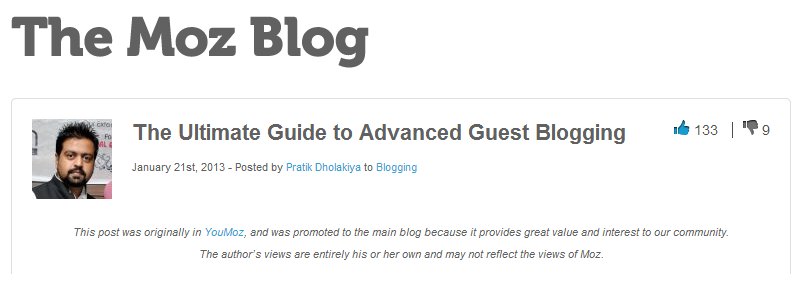Thinking of Google as that one true friend, who’ll keep sending traffic to your site, is not a good idea. Smart SEOs have wised up to the fact that a future proof SEO strategy is one that isn’t purely Google centric. If you want a strategy that offers sustainable results over the long term, it’s important to think beyond Google.
Once I realized concentrating on Google as the sole source of traffic and leads wasn’t delivering intended results, I took off my Google tinted glasses. I started searching for alternative strategies to boost traffic and which, specifically, didn’t rely on Google. Over the course of time, I’ve identified plenty of strategies that I believe, will help you move away from a Google driven SEO campaign.
This post is a follow up to my Moz post that covered 7 such strategies; it covers 17 more strategies that are an absolute ‘must use’ from the traffic and lead generation perspective.
Take a look.
Quora
For those of you who’ve never been there, Quora is a question and answer site with added social media features, like the ability to follow, to ask specific experts to answer questions that others have poised, to rack up points based on how good your answers are, and to follow specific subjects you are interested in. 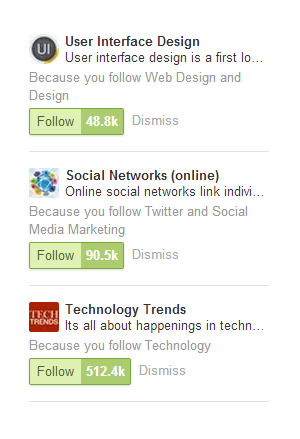
Quora’s feed suggests topics to follow.
I could also mention Yahoo! Answers here, but what really sets Quora apart is the fact that the site does a much better job of preventing trolling, and that the site measures your influence, which you can actually grow over time. It’s also much more acceptable to place links in your answers on Quora. With Yahoo! Answers, you need to be at least Level 2 in order to post links.
While no single answer on Quora is going to send a great deal of visitors, what’s truly surprising about this site is how persistent the traffic is. You might think that a question and answer site would move on very quickly, but it doesn’t work that way.
The site is designed for discovery. Your old questions keep showing up again and again for new visitors, and keep sending traffic.
Like resource lists, Quora is a good place to build up cumulative traffic. Since it also has some of the social aspects of a site like Twitter, you can also use it to build up your authority and influence over time.
On a related note, Quora is also an excellent place to get topic ideas for your blog posts.
Blog Comments
A really great blog has more than great content. It also has that active community component that makes forums and social media communities tick. Everything we said about those holds here too.
Note: It’s typically considered rude to post a link in a blog comment, and a lot of times it will get you automatically placed in a spam queue, which you may or may not ever get whitelisted out of. For the most part, you should just let your Disqus profile do the heavy lifting of linking readers to your site. Focus on adding value to the discussion with your comments. 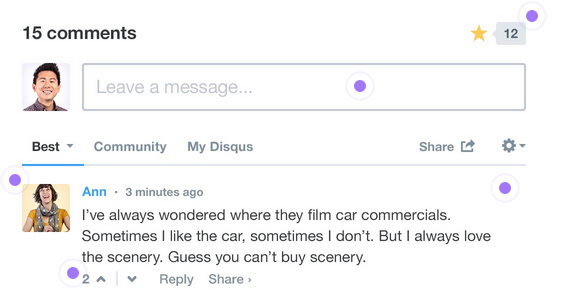
Disqus for websites
The occasional link in a blog post can work sometimes, but there are a few criteria you need to meet here:
- Most of your blog comments shouldn’t contain a link. Exception: if you frequently link to other sites in your comments, your own links will be much more forgivable.
- The link has to be relevant to the discussion at hand.
- You should only link to a resource on your site if it would take up too much space to say the same thing with a blog comment.
- Your comment should summarize the content of the link. More generally speaking, your comment should be much more “content” than “link.”
To put it another way, think about it like forum posting. A link in your signature is often acceptable, but merely posting a link rarely is.
Try to think of blog comments more like mini blog posts or forum contributions, as opposed to just saying “nice job, great post.” Add to the discussion by bringing something valuable to the table.
If you want to write a short comment, try asking a question. This gets people talking, which is the most important function of any online community.
Social Media Embeds
Social engagement metrics like “Likes” and comments play a big part in whether or not people see your posts in social media, which of course influences how many of them will click the link to your site. But with Facebook’s algorithm changes, and the sheer amount of clutter on social networks, it’s incredibly difficult to get those metrics in the first place.
Luckily, most of the major networks now allow you to embed your social media posts in your blog posts. Spending 30 seconds copying the embed code into your blog post can make all the difference. There are a few reasons why this is such a smart move:
- Social media isn’t really a place for blog posts. By that, I mean that while there are plenty of people who will click through to read a blog post, blog posts don’t really get shared. (And a “Like” is not really a “share.”) Most of the things that get shared on social networks are bite-size and visual.
- Posting the embed into a blog post ensures visibility that it won’t get in social networks, at least not at first. This initial visibility allows it to get shared enough to provide a boost in reach.
- You can use the text field of the social media post to link back to the blog post. Those who are interested in reading a full blog post can click the link to see more, while those who aren’t really interested in a full blog post can still share it with their friends or followers.
Remember that you can initially post your Facebook posts as “hidden,” or schedule them to post at the same time as your blog post. That way, the blog post and social posts can be coordinated to feed off of each other.
Guest Posts
I know I’m stating the obvious here, one reason I waited until this point to even bring this up, but guest posting on popular blogs is still one of the best ways to build up your referral traffic. Rather than tire you with yet another explanation of how to get guest posts here, I’ll refer you to our previous post on Moz: The Ultimate Guide to Advanced Guest Blogging. Everything we said then is still true today.
Reviews
This is in a similar vein to interviews. If you mention an influencer in your content, especially if you are reviewing a book or a product of theirs, they will be inclined to mention a positive review. You will almost certainly need to contact them to let them know about the review.
A lot of authors and other influencers have a page on their site where they mention favorable reviews of their books or products. These review pages are usually posted somewhere prominent on the site, and they act as resources that get visited again and again. If you get yourself listed on these pages, you can build yourself a long term source of referral traffic.
Of course, many influencers are also happy to mention favorable reviews on social networks and in their emails.
Always leave a real review of the product. During your outreach, avoid outright asking them to link to the review, especially not in your first email. Instead, use the review as a jumping-off point to give context to the following discussion. Start things off by asking if they would like to take a look at the review.
Also, it doesn’t technically have to be a review. It could also be a “top 10 list,” or simply a favorable mention in a blog post about something related. If you have any affiliates links on your site, this is probably a good place to start, since you already have a working relationship, to some extent.
PPC Search Ads
This one’s sort of obvious, but a lot of us “inbound marketers” tend to dismiss this one so easily that it doesn’t even come to mind, when it really should. Consider that even HubSpot, the king of Inbound, uses search engine ads. 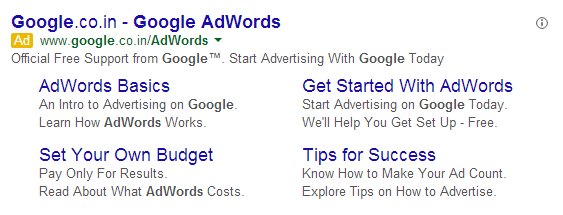
Google AdWords uses Google Ads too!
A few things to keep in mind when it comes to the science and art of search engine advertising:
- Avoid advertising for keywords involving words like “free,” which can get a high number of clicks but no sales, actually losing you money
- Build a different landing page for each search query that means something substantially different. You want the visitor to feel almost like you read their mind with the landing page. Increasing your number of landing pages from 10 to 15 can increase your number of leads by 55 percent according to HubSpot. Don’t try to force every visitor onto the same landing page. The greatest gift that search engine ads have to offer is the level of targeting involved.
- Track the individual performance of each keyword, not just the overall performance of your campaign. There is a good chance that some of your keywords will actually be losing you money. You want to cut your losses as soon as possible.
- Split test your ads for each keyword in order to determine which ads are most profitable (not to find out which have the highest CTR).
- Split test your landing pages. Focus on landing page concepts before fiddling with individual site elements.
Of course, a lot of this applies for affiliate advertising as well.
Press Releases
While Google has made it clear that nobody should expect a do-follow link from a press release to help your rankings, this doesn’t mean that press releases aren’t a good way to get traffic. Press Release sites are still where many journalists find news stories to cover. If your business earns coverage in a mainstream news publication, you can bet the referral traffic will make a difference.
Of course, you can’t just publish a press release about anything and expect it to make a difference. Here are a few things to keep in mind:
- The topic of the press release must be newsworthy. There needs to be a story. You can’t publish a press release about a new product (unless it’s revolutionary), a discount, or a new marketing campaign, and expect it to make a difference. Think in terms of publicity stunts, hoaxes, and guerrilla marketing. Consider the billionaire who buried his Bentley so he could use it in the afterlife, only to have the ingenious stunt later be revealed as a statement in favor of organ donation. These are the kinds of press releases that will actually get talked about in the news.
- The press release should point journalists to a resource page featuring all of the information a journalist would want to have, including high quality photos that they can publish along with the story. The page should also feature a contact form for journalists to inquire for more information. This page should feature a short summary of the story as well as more in depth facts. Try to encourage linking back to your site by sharing images as embeds, and by asking journalists to link to your resource page as the source for their information.
- Don’t publish your press release on just any PR site. Make sure it is the kind of press release site that journalists actually use. It’s also a good idea to get it published in at least one major industry publication. For example, if your story were science related, you wouldn’t just want to press release to show up in PRWeb. You would also want it to show up in EurekAlert.
 Image Credit: Nashville Corps, Flickr
Image Credit: Nashville Corps, Flickr
Pinterest is similar in some ways to social bookmarking sites like Reddit and StumbleUpon. As you probably know, Pinterest is a social “scrapbooking” site that allows you to post images you find on the web, or “re-pin” images that others have pinned. And, like Reddit, the site has the power to send massive amounts of traffic.
In fact, Pinterest currently sends out more referral traffic overall than any social media site except for Facebook: 30.06 percent of all social media referral traffic.
But, unlike Reddit and StumbleUpon, the site is much more commercialism-friendly, provided you know how to use the site properly.
So, how should you go about using the site: 
Sign up for Pinterest
- For starters, keep in mind that Pinterest’s primary demographic is female, and that the subject matter sticks pretty closely to homemaking, DIY, crafts, and so on. If your target customers are too far away from that primary audience, Pinterest might not be a good place to get involved.
- Give every blog post a “title image.” This image acts as a lead-in to your blog post, and it’s primary purpose is to entice pinners to click through and see what the blog post is about. Anything that acts as a guide is more likely to work well.
- Make sure the photography on your blog is very high quality. Take a look at some of the images on Pinterest and you’ll quickly realize that, for the most part, only professional photographs fair well on the site.
- Use images that are unique, not just in the sense that you can’t find them elsewhere, but in the sense that they will be stunning to look at because the idea behind the image is novel. You want to show people things that they wouldn’t have thought of on their own. This is a huge part of what makes things shareable.
- Visual guides, “instructographics” as Colby Almond calls them, do incredibly well. The key is to create an instructographic that explains how to complete some task, to present it in a visually appealing format, and to lay it out in a way that makes it appealing on Pinterest, but only useful if they click through to see the full image on the site.
- Make it easy for users to pin images on your site. Place a “pin it” link right below your images to minimize work on your visitor’s side of things.
- While Pinterest is friendlier to marketers than Reddit, most of the things that you post to Pinterest still shouldn’t be your own content. Instead, you should maintain several boards focused on topics that you cover on your site, and merely sprinkle your own content onto these boards.
- Try not to overthink things. Take a look at your Pinterest analytics and find out which pins are doing best, and try to emulate those. While you should certainly run plenty of creative experiments, for the most part you should stick with what works.
By the way, keep in mind that most of these strategies work very well with Facebook, and many other social networks, as well.
Email Signatures
While this won’t make a huge difference for you, it also hardly takes any effort at all. Simply add a link in your email signature that points to your single most valuable resource. Now, anytime you send an email, you also have a traffic opportunity.
While I discourage actively linking to one of your posts in the body of the first email you send to an influencer (since this can immediately put them on the defensive), this is rarely a problem in your email signature. It’s clear that the link in your email signature isn’t the point, of the email, so it doesn’t get interpreted as an immediate spam flag.
The same goes for signatures on any other platforms where they are welcome, such as a forum profile.
Go Quote Hunting
While this tactic has been somewhat abused within the “marketing” niche, this option is still wide open in most other corners of the market.
The idea is simple. Contact a wide variety of influencers and ask for their advice or their opinion on a single, important issue. Focus on questions that can be answered in a single sentence or paragraph. Then use those answers to create a list of influencer opinions, and post it as a prominent resource on your site.
Now, after the post is published, just let the influencers know about the post. Thank them for helping you put together a valuable resource, and let them know you would appreciate it if they shared it with their network.
The end result is an incredibly valuable resource on your site that will also be shared and promoted by a fair number of influential people.
Launch a Game
I’m the first to admit that this isn’t going to work for every business.
That said, here’s how people are using their time online: 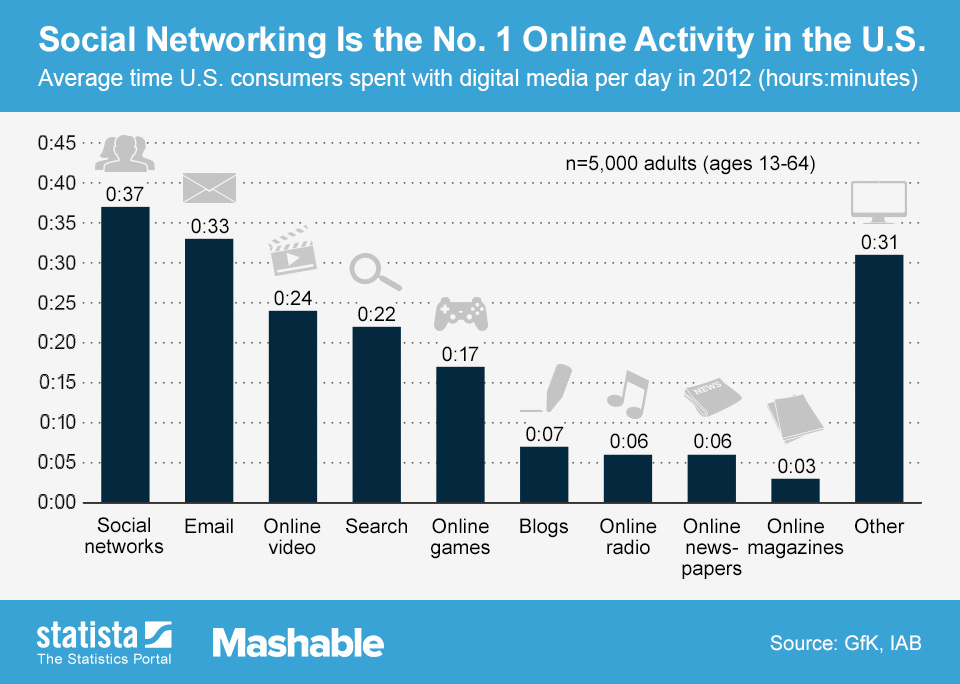 As you can see, people are spending an awful lot more time playing online games than they are reading blogs. And then there’s this:
As you can see, people are spending an awful lot more time playing online games than they are reading blogs. And then there’s this: 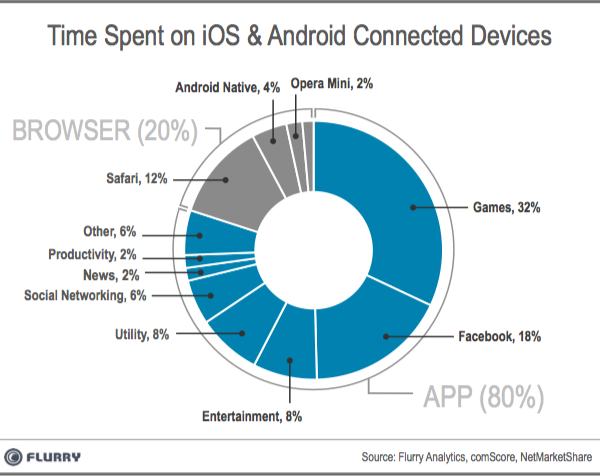 When it comes to mobile, people are actually spending more time playing games than using their actual web browser.
When it comes to mobile, people are actually spending more time playing games than using their actual web browser.
It should go without saying that games can be costly to develop, and there’s not always a natural way to connect them to business metrics. I don’t think this is the kind of thing you should force. But if you can find a creative way to link a simple game to your target audience, and use it to drive traffic, links, and email subscriptions, this can be a smart way to stand out.
You don’t necessarily need a full-fledged game, either. You can also embrace the fuzzier concept of “gamification,” which blends together elements of traditional loyalty programs with elements borrowed from gaming.
Tadhg Kelly, a gaming designer with 20 years of experience, had this to say about gamification over at TechCrunch:
- Focus on boosting a single metric like sales, repeat visits, or time on site. Trying to do all three at once results in too much complication.
- Users can smell empty internet points a mile away and won’t collect points just because they can (except for a few outliers that you should ignore).
- The core concept of your game or gamified platform should be explainable in a sentence.
- You probably shouldn’t use badges, achievements, levels, or experience points unless there’s some very clear reason for them to exist, and their usually isn’t.
- The only incentives that work reliably are points awarded by other users as validation, completion of tasks that have at least some semblance of real meaning, and real-world prizes as rewards.
- Don’t place too many bets on your gamified concept being “intrinsically rewarding.” Unless the game is exceptionally fun to play, expect your users to be playing primarily for validation from others and for some kind of financial compensation.
It should also go without saying that you shouldn’t be using gamification as a “clever” scheme to pay people for Likes on Facebook or links on the web. Both are violations of their respective company’s terms of service, and are simply a bad way to market yourself in the first place.
YouTube
Everybody knows that the internet is becoming more visual, and that people love video. A lot of you have probably also heard that YouTube is now officially more popular than Facebook among teens. But what many of you might not realize is that YouTube is also better at sending long term referral traffic than any of the social networks.
We’ve noticed that links from YouTube videos tend to send visitors for a very long time after they are published. This is because YouTube is designed for discovery. People browse the site endlessly and discover things that they wouldn’t even think to look for. We’ve also noticed that referrals from YouTube tend to have some of the longest “time on site” metrics.
At the same time, if we’re allowed to call YouTube a search engine, it’s the second most widely used search engine in the world, and the competition is so weak. Keyword use is far less saturated on YouTube than the internet at large.
Add to that the fact that videos stand out in Google’s search results with thumbnails, and you’ve got yourself a very good reason to use YouTube as a source of referral traffic and brand exposure.
Forums
While they might seem more than a little “web 1.0,” forums and message boards are still some of the best places on the web to find your target audience, build a following, and capture attention.
Not convinced?
How about this. Forty-five percent of American social media users visit a message board every day. Sixty-two percent visit one every week. This is more than the number of people who visit blogs.
Take a look at the top sites in your industry. Chances are, a good portion of them have forums. And guess what. Those forums are probably making them more money than any mainstream media exposure they happen to receive.
At the very least, this is the case with a non-profit microlending organization called Kiva. We recently talked about a scientific study, published in the Journal of Marketing Research, which followed how forum activity influenced Kiva’s “sales.” The result? Percent changes in forum activity had 30 times more impact on revenue than mainstream media stories.
While forums aren’t as heavily used as social networks, they are still immensely popular, and they are populated by people who undoubtedly have a targeted interest in the subject of the forum in question. 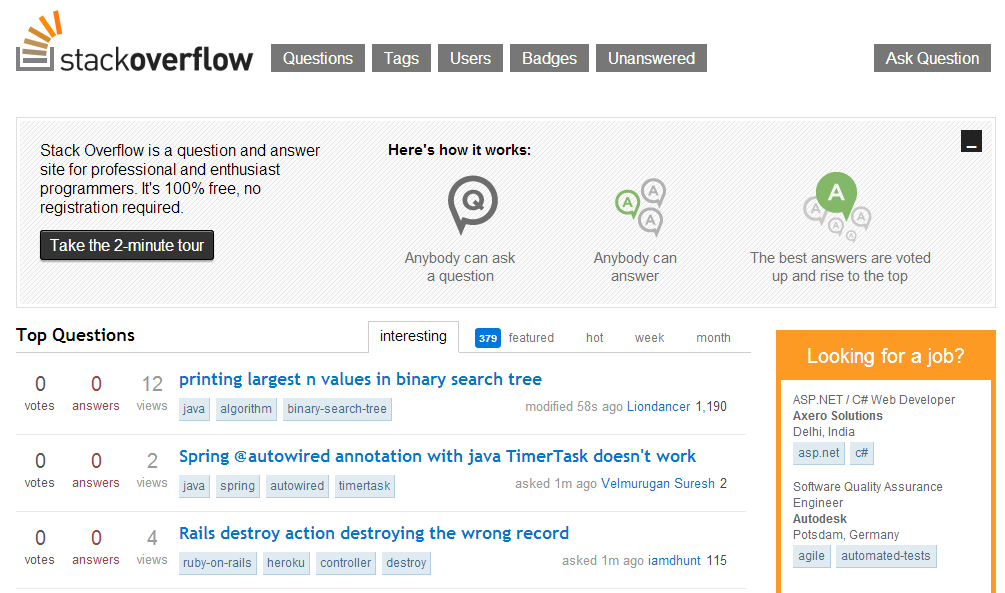
StackOverflow is arguably the most popular forum among programmers, with 2.7 million members and over 6 million threads.
SEOs have largely ignored forums because most of the links are no-followed, but this is a huge mistake. With more visitors (who are also more engaged) than blog audiences, forums are a tremendous place to capture a relevant audience.
Invest value in these communities. You’ll thank me later.
Slideshare
If you haven’t heard of it, Slideshare.net is a place to post slideshows that users can browse through. Executed properly, it can be an amazing source of referral traffic. Ana Hoffman was able to use it to capture 243,000 views and 1,400 referrals in 30 days. Here are a few things you need to know to make it work:
- To make the front page of Slideshare, where the real traffic opportunities lie, you will need to get a lot of attention on social networks. The bottom of the front page is populated by presentations that are trending on social media. The featured posts and top posts are hand-curated.
- To increase your visibility, you want to embed your presentations on your blog, and in as many other places as you can. This visibility helps you trend on social networks, and can increase your chances of being chosen for the front page.
- Make sure to add two calls-to-action into your presentation: one with clickable social media sharing buttons, and one with a clickable link to a resource on your site.
- Use your presentation like a bullet point list summarizing a resource or blog post, and use the call to action to drive referrals to learn more.
- Use Creative Commons images, or images that you own the copyrights to, in your presentation. If you can’t, make sure you abide by Fair Use guidelines, and make an effort to give credit to the original image creator.
- Slideshare also has a most popular section, and while it’s not on the front page, it’s still a good place to earn exposure. Again, embeds can help you bump this number up so that you can be more visible on this page.
- Remember that these presentations are meant to be browsed on the internet, not presented in front of a boardroom. Users should be able to get all of the information they need from the presentation itself, no presenter required.
Ana Hoffman’s “Milk Slideshare” presentation
Slideshare is also a good place for discovery. Related presentations are listed in the sidebar next to each presentation. For this reason, Slideshare continues to send a decent amount of referral traffic even after your presentation falls of the front page (or never makes it to the front page to begin with).
Keep in mind that Slideshare is best for B2B purposes, and that you should avoid getting too niche if you want to make the front page.
Social Bookmarking
Social bookmarking sites like Reddit and StumbleUpon are some of the biggest referrers on the web. Reddit currently sees 731 million unique visitors per month, and while their number of outbound referrals has actually gone down over the past year (for sites that aren’t Imgur), if your site hits the front page you can easily pick up 100,000 visitors (and server loads resembling a small DDOS attack).
Meanwhile, StumbleUpon is a great source of long-term referral traffic if enough visitors happen to thumb-up your content.
At the same time, it’s important to realize that these sites have unique needs, and your knowledge of sites like Facebook probably won’t prepare you for how to interact on these sites.
- Reddit is extremely anti-marketing and will not upvote anything with the slightest hint of commercialism (except in a few niche tech and gaming markets). Self-promotion is viewed with extreme skepticism and should only be done on occasion using accounts that primarily promote and discuss subjects and sites completely unrelated to your own.
- Neither Reddit nor StumbleUpon should be seen as a place to build a following on-site. Reddit is a good place to interact, and relationships can start on Reddit, but unless you happen to be one of a very small number of famous Redditors, your karma score and other factors won’t impact your influence on the site at all. As for StumbleUpon, only votes from strangers who Stumble across your content using StumbleUpon will help your visibility.
- With StumbleUpon, the most you should really do is set up a profile and submit a link. Further interaction doesn’t really help anything.
- Don’t build your site around social bookmarking sites. They are a great source of referral traffic, but both are unreliable and can’t be counted on as a consistent source of new traffic.
- If you are caught using multiple accounts to upvote your content (or downvote competitors) on either site you can be permanently banned. It’s better to never promote your content on these sites than to promote it too much.
Launch a Utility
The first thing you see when you go to Neil Patel’s Quicksprout is a free SEO tool. Quicksprout has a blog, and employs content marketing on a regular basis, but Neil has opted to choose a utility for the front page over anything else on his site.
There’s a very good reason for that.
According to Open Site Explorer, Quicksprout’s homepage has a Page Authority of 77. And speaking of Open Site Explorer, it’s got a Page Authority of 85.
People love linking to utilities.
This isn’t limited to the marketing niche. You may have heard of a little online utility called Google, or perhaps a small company that goes by the name of Adobe.
No matter how good your outreach is, and no matter how awesome your blog posts are, it’s hard for traditional blog outreach to stand out. As good as your content is, most people will still ignore you the very second you bring up your blog.
Utilities are different. If you’ve got a functioning piece of code on your site, a tool that actually does some kind of work that will make somebody’s life easier, you will be taken seriously. While “anybody” can do “content” (even if it’s not, you know, any good), a much smaller group of people can actually put together a utility for others to use.
Journalists and bloggers also have a much more compelling reason to link to you. If all they do is link somebody to another blogger, the best they can do is send their audience to somebody with some really compelling advice or very entertaining content. But if they link to a utility, they can send their visitors to a piece of code that will actually give them the ability to do things they couldn’t do before.
That’s a big difference.
One of the most innovative things about the internet is the ability to provide users with more than just text, images, and videos. It’s also a platform for software. And the thing is, most corners of the market are completely vacant in that department.
Few things will make you stand out more.
Post a Quiz
ave you taken a look at some of the top stories on BuzzFeed lately? Here’s what it looks like as of April 11, 2014:  These three posts, each with well over a million views, sitting at the top of the weekly charts, all have one thing in common. Every single one of them is a quiz.
These three posts, each with well over a million views, sitting at the top of the weekly charts, all have one thing in common. Every single one of them is a quiz.
These quizzes are extremely shareable for a few different reasons:
- They are interactive. It’s not just you absorbing content. You’re involved in the process.
- Two of them are very visual, and the other one is at least visually styled in a way that is different from a blog post.
- They are very relatable for many of the people who will see them. The users that these quizzes are made for will feel almost like the quiz was made just for them because so many of the pop-culture references are memorable for them.
- They are easy to talk about. In fact, you almost feel compelled to talk about them after taking the quizzes. (I mean, remember how awesome “The Mighty Ducks” was? I haven’t thought about that movie in years.)
- Sharing the quiz with somebody else can actually be a bonding experience.
You can use a free tool like QuizBox to add a quiz directly to your blog.
Don’t Get Overwhelmed
I agree, 17 strategies are one too many. But, you don’t have to try out all of them at the same time. Pick and choose. Go with what you believe is the right fit for your needs. There might be a bit of trial and error involved, but once you are able to identify strategies that work for you, stick with them and continue refining them. You will soon find your dependency on Google going down; your SEO strategy won’t begin and end with this search engine.
36,769 total views, 2 views today

